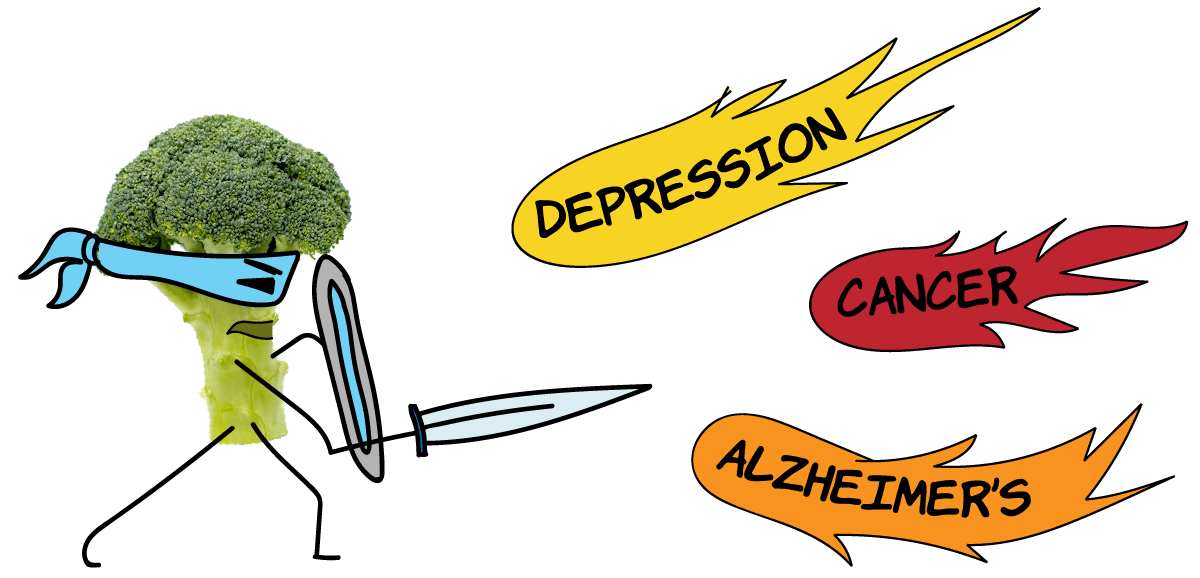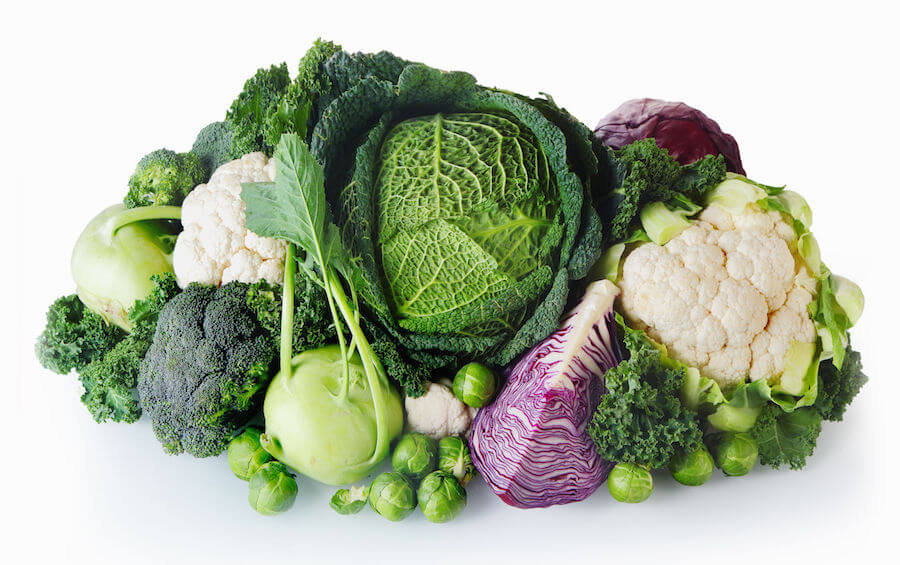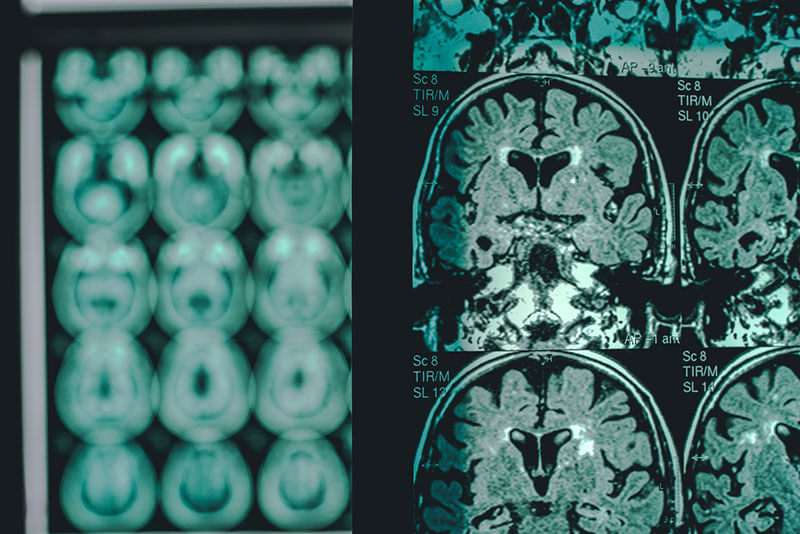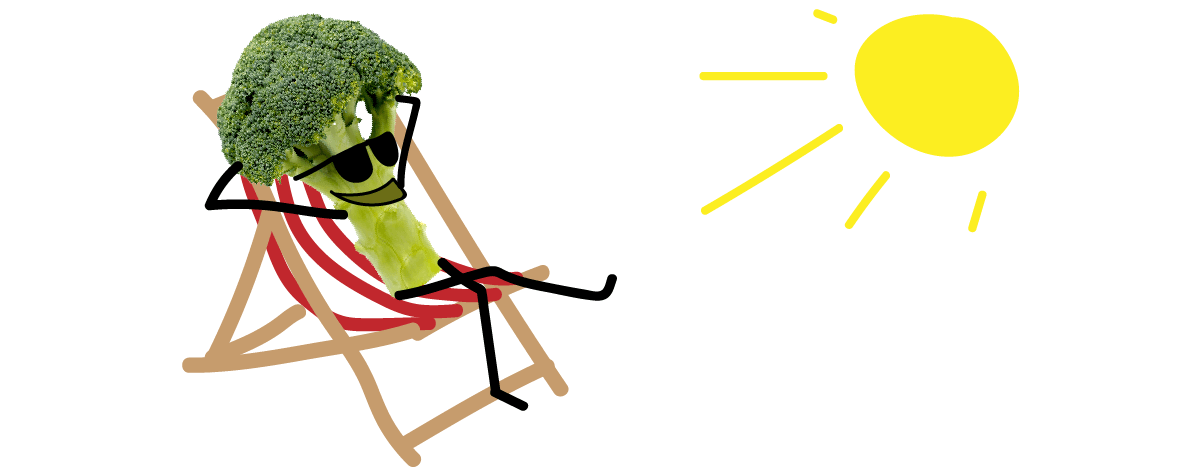Do you remember when your mom said ‘Eat your broccoli!’? Do you remember how annoying that was? Well, she was right! And the reason is sulforaphane. Sulforaphane in broccoli can greatly reduce your cancer risk, detoxify your system, and even work towards reducing Alzheimer’s.

It all comes down to the fact that inflammation eventually kills you and sulforaphane can help fight inflammation. No matter how healthy you try to live, you will have inflammation going on somewhere in your body—whether it’s a reaction to pollutants you breathed in, from sunlight, as a reaction to diet and even exercise, or simply aging—there is no way to escape inflammation. Mostly, our bodies do quite a good job of keeping everything under control but given the high exposure to the toxins of a modern world, it makes sense to support our bodies in fighting inflammation. Precisely that’s what sulforaphane does—and very effectively.
I discovered that not only broccoli, but all so-called cruciferous vegetables contain sulforaphane in varying amounts. What are cruciferous vegetables, you might ask? The word ‘cruciferous’ is derived from the petals having a cross-like shape. Think broccoli, brussels sprouts, garden cress, mustard greens, turnips, cabbage, kale, watercress, kohlrabi, broccoli, radish, cauliflower, rocket, and bok choy (yummy!). The most effective way to get lots of sulforaphane into your body is by eating broccoli sprouts. I’ll go into details later.

Lowering inflammation & detoxification
Consuming sulforaphane regularly causes a reduction in blood inflammation markers, LDL and blood glucose.1 2 Furthermore, it enhances the excretion of harmful compounds we are all exposed to on a daily basis.
Sulforaphane can aid in detoxification of airborne pollutants. Just 24 hours after consuming a broccoli sprout smoothie, people washed out 61% more of harmful benzenes, which are found in airborne pollutants and cigarettes.3 Benzene is a carcinogen of which smokers consume up to 2 mg of daily. Compare that to non-smokers who consume only 0.2 mg probably from air pollution and secondhand smoke.4 Eating just 4.5 servings of raw cruciferous vegetables per month reduced the lung cancer risk of smokers by 42%, and there was an even stronger association for those who smoked for less than 30 years.5 Amazing right? So if you smoke, the best thing to do is quit. But if that is not an option, definitely make sure you are getting enough sulforaphane into your system.
Cancer prevention
Evidence has found sulforaphane to be a powerful agent in cancer prevention. Three to five servings of cruciferous vegetables per week decreased men’s risk of prostate cancer by 41%.6 Supplementing patients who had been operated for prostate cancer with 60 mg of sulforaphane caused a slowing down of the doubling rate of the prostate cancer tumor marker by 86%.7 Men who ate more than five servings of cruciferous vegetables had a 51% decrease in their bladder cancer risk.8
In healthy women, sulforaphane accumulates in the breast tissue where it may act preventatively against breast cancer. From animal studies we know that sulforaphane can turn on an important gene involved in detoxification within breast tissue.9 There are quite a few studies showing that women who consume cruciferous vegetables at least once a week had between a 17-50% decrease in breast cancer risk.10 This huge variation is probably due to the fact that (1) the bioavailability of sulforaphane is extremely varied in cruciferous vegetables and (2) it greatly depends on how you eat them; we’ll talk more about this in the next blog post.
Reducing neurodegenerative disease
Some areas of your body are especially sensitive to inflammation. One of them is your brain. Neurodegenerative disease such as Alzheimer’s, Parkinson’s and Huntington’s disease have all been linked to brain inflammation. Researchers have shown that sulforaphane can cross the blood-brain barrier in mice11, so we expect this to be similar in humans, which means it can also have an impact on processes in the brain.

Mice induced with neurodegenerative diseases have shown improvements in pathologies after sulforaphane injections. Sulforaphane has also shown the ability to enhance neurite outgrowth, which is a way neurons repair themselves after injury such as a traumatic brain injury. Additionally, results from this study showed that juvenile and adolescent mice fed with a sulforaphane-enriched diet had less stress-induced depression-like behaviors as adults.12
This is super exciting, as it shows that sulforaphane taken in adolescence, may act as a prophylactic for depression and may enhance stress resistance. So parents, although this has only been shown in animals, it definitely can’t harm to feed your kids cruciferous vegetables on a regular basis.
Decreasing depression
Nutrition has a huge impact on depression by affecting not only synthesis of neurotransmitters but also inflammation levels in your body. Why is that? Remember that inflammation harms your body, thus your immune system produces little cells that fight the inflammation. Unfortunately, these cells are built from the same amino acid that your brain uses to produce serotonin; it’s called tryptophan. Now, if you have constant inflammation going on in your body, there might not be enough tryptophan left for the brain to synthesize sufficient levels of serotonin which, in turn, can cause depression.13
In studies involving mice, researchers induced depression by inflammation and then showed they could reverse it by giving the mice sulforaphane. They even went as far as showing that sulforaphane can decrease depressive symptoms with the same efficacy as Prozac.14 This has only been shown in animals but because we know sulforaphane decreases inflammation in humans and we know inflammation can cause depression, it’s reasonable to hypothesize that sulforaphane may decrease symptoms of depression.
Positive effects on autism
Young men with moderate to severe Autistic Spectrum Disorder (ASD), have also shown improvement when consuming sulforaphane daily for 18 weeks. Improvements were seen in social interaction, aberrant behavior and verbal communication.15
Protection from sunburn
Even our largest organ – our skin – is affected by sulforaphane. Topically applied, three-day old broccoli sprout extract protected human skin from sunburn.16 So maybe we will soon be finding broccoli sprout extract in our sunscreens and after sun products? It certainly wouldn’t surprise me.

What’s the take-home message?
To sum up, there is plenty of evidence showing links between the consumption of sulforaphane, found in cruciferous vegetables, and the reduction of certain cancers and cardiovascular risks, as well as improvements in neurodegenerative disease and in detoxification of airborne pollutants.
Currently, there are 12 clinical trials investigating the effects of sulforaphane, four looking into links with autism, three looking into it as a cancer treatment, and the rest looking into all sorts of possible treatments from allergic rhinitis to schizophrenia. This means we will get new insights very soon.
Our next two posts on sulforaphane will deal with
- How it works in your body, and
- What you can do to maximize your dietary intake. Because simply eating broccoli soup every day won’t do the trick.
Stay tuned. You can also sign up for our mailing list and get notified when we publish part two and three of this series.
References
-
Bahadoran Z, Mirmiran P, Hosseinpanah F, et al. Broccoli sprouts powder could improve serum triglyceride and oxidized LDL/LDL-cholesterol ratio in type 2 diabetic patients: a randomized double-blind placebo-controlled clinical trial. Diabetes Res Clin Pract. 2012 Jun;96(3):348-54. doi: 10.1016/j.diabres.2012.01.009. Epub 2012 Feb 9. PubMed PMID: 22325157 ↩
-
Axelsson AS, Tubbs E, Mecham B, et al. Sulforaphane reduces hepatic glucose production and improves glucose control in patients with type 2 diabetes. Sci Transl Med. 2017 Jun 14;9(394). pii: eaah4477. doi: 10.1126/scitranslmed.aah4477. PubMed PMID: 28615356. ↩
-
Egner PA, Chen JG, Zarth AT, et al. Rapid and sustainable detoxication of airborne pollutants by broccoli sprout beverage: results of a randomized clinical trial in China. Cancer Prev Res (Phila). 2014 Aug;7(8):813-23. doi: 10.1158/1940-6207.CAPR-14-0103. Epub 2014 Jun 9. PubMed PMID: 24913818 ↩
-
Wallace L, Pellizzari E, Hartwell TD, et al. Exposures to benzene and other volatile compounds from active and passive smoking. Arch Environ Health. 1987 Sep-Oct;42(5):272-9. PubMed PMID: 3452294 ↩
-
Tang L, Zirpoli GR, Jayaprakash V, et al. Cruciferous vegetable intake is inversely associated with lung cancer risk among smokers: a case-control study. BMC Cancer. 2010 Apr 27;10:162. doi: 10.1186/1471-2407-10-162. PubMed PMID: 20423504. ↩
-
Cohen JH, Kristal AR, Stanford JL. Fruit and vegetable intakes and prostate cancer risk. J Natl Cancer Inst. 2000 Jan 5;92(1):61-8. PubMed PMID: 10620635. ↩
-
Cipolla BG, Mandron E, Lefort JM, et al. Effect of Sulforaphane in Men with Biochemical Recurrence after Radical Prostatectomy. Cancer Prev Res (Phila). 2015 Aug;8(8):712-9. doi: 10.1158/1940-6207.CAPR-14-0459. Epub 2015 May 12. PubMed PMID: 25968598. ↩
-
Michaud DS, Spiegelman D, Clinton SK, et al. Fruit and vegetable intake and incidence of bladder cancer in a male prospective cohort. J Natl Cancer Inst. 1999 Apr 7;91(7):605-13. PubMed PMID: 10203279 ↩
-
Cornblatt BS, Ye L, Dinkova-Kostova AT, Erb M, et al. Preclinical and clinical evaluation of sulforaphane for chemoprevention in the breast. Carcinogenesis. 2007 Jul;28(7):1485-90. Epub 2007 Mar 7. PubMed PMID: 17347138 ↩
-
Terry P, Wolk A, Persson I, Magnusson C. Brassica vegetables and breast cancer risk. JAMA. 2001 Jun 20;285(23):2975-7. PubMed PMID: 11410091; Wu YC, Zheng D, Sun JJ, et al. Meta-analysis of studies on breast cancer risk and diet in Chinese women. Int J Clin Exp Med. 2015 Jan 15;8(1):73-85. eCollection 2015. PubMed PMID: 25784976 ↩
-
Jazwa A, Rojo AI, Innamorato NG, et al. Pharmacological targeting of the transcription factor Nrf2 at the basal ganglia provides disease modifying therapy for experimental parkinsonism. Antioxid Redox Signal. 2011 Jun 15;14(12):2347-60. doi: 10.1089/ars.2010.3731. Epub 2011 Mar 28. PubMed PMID: 21254817 ↩
-
Yao W, Zhang JC, Ishima T, et al. Role of Keap1-Nrf2 signaling in depression and dietary intake of glucoraphanin confers stress resilience in mice. Sci Rep. 2016 Jul 29;6:30659. doi: 10.1038/srep30659. PubMed PMID: 27470577 ↩
-
Rhonda Patrick on Joe Rogan: #901: http://podcastnotes.org/2017/02/13/jre-901-rhonda-patrick-is-back/ ↩
-
Martín-de-Saavedra MD, Budni J, Cunha MP, et al. Nrf2 participates in depressive disorders through an anti-inflammatory mechanism. Psychoneuroendocrinology. 2013 Oct;38(10):2010-22. doi:10.1016/j.psyneuen.2013.03.020. Epub 2013 Apr 23. PubMed PMID: 23623252 ↩
-
Singh K, Connors SL, Macklin EA, et al. Sulforaphane treatment of autism spectrum disorder (ASD). Proc Natl Acad Sci U S A. 2014 Oct 28;111(43):15550-5. doi: 10.1073/pnas.1416940111. Epub 2014 Oct 13. PubMed PMID: 25313065 ↩
-
Knatko EV, Ibbotson SH, Zhang Y, et al. Nrf2 Activation Protects against Solar-Simulated Ultraviolet Radiation in Mice and Humans. Cancer Prev Res (Phila). 2015 Jun;8(6):475-86. doi: 10.1158/1940 6207.CAPR-14-0362. Epub 2015 Mar 24. PubMed PMID: 25804610 ↩
